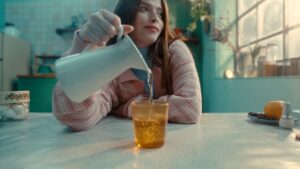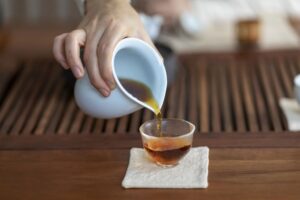I’ll admit it—when I first tried green tea, I wasn’t a fan. The bitterness was hard to ignore, and I wondered why so many people raved about it.
But with a little experimentation and some helpful tips, I learned how to brew green tea properly and discovered ways to enhance its flavor.
Now, it’s a staple in my daily routine. If you’ve ever struggled with enjoying green tea, let me share what worked for me.
Types of Green Tea

- Japanese Green Tea: These teas, like matcha and Sencha, are steamed. They have a fresh, grassy flavor that feels vibrant and light. I like to brew these at lower temperatures to keep their delicate taste intact.
- Chinese Green Tea: These teas, such as Gunpowder and Longjing, are roasted. They have a slightly smokier, nuttier flavor, which I find comforting and rich.
Brewing Temperatures Matter
Green tea leaves are delicate and require precise brewing conditions to unlock their full potential.
Using water that’s too hot can scorch the leaves, leading to a bitter and unpleasant flavor. Conversely, water that’s too cool may not extract the full range of flavors and beneficial compounds.
Through research and personal experimentation, I learned that the ideal water temperature for brewing green tea typically falls between 160°F to 180°F (70°C to 80°C).
In the beginning, I made the common mistake of pouring boiling water directly over the tea leaves, unaware of the damage it caused.
The result was a consistently bitter brew that was far from enjoyable. Determined to improve, I invested in a reliable thermometer and began heating my water more carefully.
For Japanese green teas, I aimed for a temperature range of 150-170°F (65-77°C), while for Chinese varieties, I targeted 170-180°F (77-82°C).
Why I Drink Green Tea
Once I nailed the brewing process, I started appreciating green tea for more than just its flavor. Its health benefits are impressive and have motivated me to make it a part of my daily life.
Key Health Benefits
- Weight Management: Green tea has helped me stay on track with my fitness goals. Its natural compounds can boost metabolism, making it easier to burn calories.
- Mental Clarity: The combination of caffeine and l-theanine provides a calm focus. I feel alert without the jittery energy that coffee sometimes gives me. Interestingly, Earl Grey tea also contains caffeine, though typically less than coffee or green tea, offering a gentler pick-me-up.
- Heart Health: Drinking green tea regularly may help lower cholesterol and improve cardiovascular health. Knowing this makes each cup feel like an investment in my well-being.
- Antioxidant Boost: It’s packed with catechins and flavonoids, which support my overall health and keep me feeling good.
The more I learned about these benefits, the more I wanted to explore the world of green tea.
How I Make Green Tea Taste Great
Brewing green tea is both an art and a science, and it took me a few tries to get it right. Here’s my step-by-step method:
1. Perfecting the Brew
@nioteas Green tea doesn’t need to be hot! 🧊 🍵 #icetea #icedtea #coldbrew #coldbrewtea ♬ original sound – Nioteas
- Water Temperature: I use a thermometer to make sure my water is between 175-180°F. If I don’t have one handy, I let the boiled water cool for about 2 minutes before pouring it over the leaves.
- Steeping Time: I’ve learned to steep for only 1-2 minutes. Any longer, and the tea becomes bitter.
- Type of Water: Purified or spring water makes a noticeable difference. Tap water can dull the flavor, so I avoid it.
2. Choosing Quality Tea
Switching to loose-leaf tea was transformative. Unlike the confined space of tea bags, loose leaves have room to unfurl fully, releasing a richer array of flavors and aromas.
I typically use about a teaspoon of loose leaves per six ounces of water, adjusting slightly depending on the tea variety. Investing in high-quality teas from Japan or China has been worthwhile; they not only taste superior but also offer enhanced health benefits.
3. Experimenting with Brewing Techniques

Exploring different brewing methods has been both enjoyable and enlightening:
- Cold Brewing: By steeping green tea in cold water overnight, I’ve created a mellow, refreshing drink that’s perfect for summer. This method reduces bitterness and results in a smoother flavor profile.
- Ice Brewing: This involves placing ice cubes over tea leaves and allowing them to melt slowly. The gradual infusion produces a delicate, sweet flavor that’s truly unique. It’s a slower process but rewarding for those seeking a nuanced taste experience.
My Favorite Green Tea Add-Ins
Sometimes, I like to enhance the flavor of my green tea with healthy add-ins. Here are some of my favorites:
- Lemon Juice: A squeeze of fresh lemon brightens the tea and adds a boost of vitamin C.
- Honey: A touch of honey balances the earthy notes and adds a natural sweetness.
- Mint Leaves: Fresh mint gives the tea a cooling, refreshing twist.
- Ginger: Adding a slice of fresh ginger makes the tea warm and slightly spicy, perfect for cold days.
These small additions can completely transform the flavor, making each cup feel new and exciting.
Why Quality Matters
View this post on Instagram
One of the most important lessons I’ve learned is that the quality of the tea matters. Premium loose-leaf teas from reputable sources offer richer flavors and better health benefits.
If you’re just starting out, try a few different types and see which one resonates with you. My personal favorites are matcha for its creamy, bold taste and Longjing for its subtle, nutty flavor.
Making Green Tea a Daily Ritual
Now that I know how to brew green tea properly and customize it to my liking, it’s become a daily ritual. In the morning, it’s my go-to beverage to wake up gently and focus on the day ahead. In the afternoon, a cup of iced green tea with mint feels like a treat. And when I’m winding down at night, a warm, lightly sweetened cup of green tea is the perfect way to relax.
On days when I want something a bit different, I love brewing a soothing cup of lemongrass tea, which adds a refreshing citrus note that’s both calming and invigorating.
If you’ve struggled with green tea in the past, I encourage you to give it another try. By adjusting the brewing process and experimenting with add-ins, you can find a way to make it work for you. Green tea is more than just a beverage—it’s a small step toward a healthier, more mindful lifestyle.
Cheers to making green tea a drink you’ll love! Let me know how you prepare yours or what add-ins you enjoy most. I’d love to hear about your tea journey.




